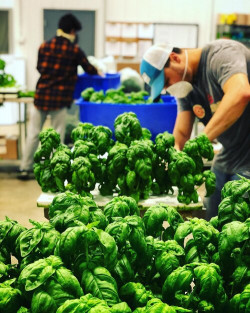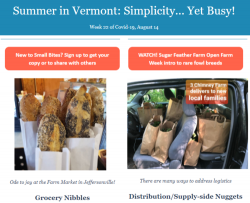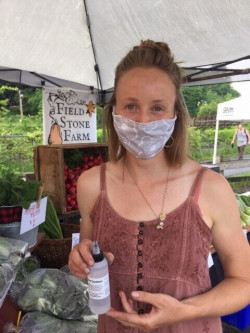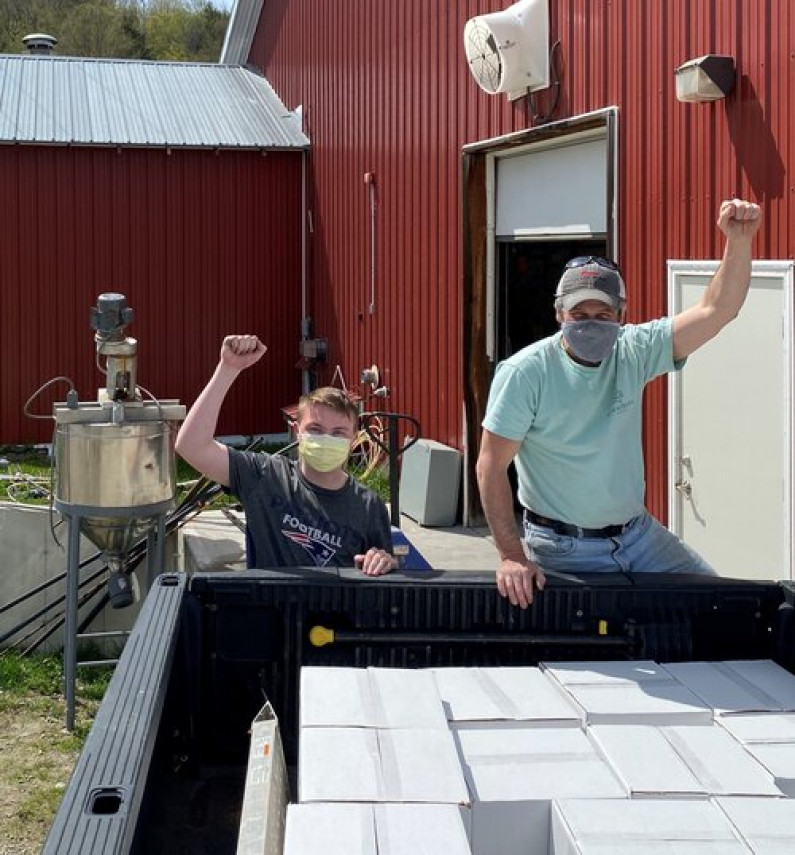
CERES GREENS, A VERTICAL FARMING COMPANY BASED IN BARRE, IS ONE OF MANY VERMONT FOOD BUSINESSES THAT HAVE SHIFTED THEIR BUSINESS MODEL TO SURVIVE THE PANDEMIC. PHOTO CREDIT: CERES GREENS.
The COVID-19 pandemic has disrupted the food supply chain, both for eaters and for producers of food. Some of Vermont’s largest local food purchasers – restaurants, colleges, schools – closed or reduced their capacity, taking down long-reliable slices of revenue for Vermont growers. Vulnerabilities in our national food supply chain led to empty shelves for staple products, including meat and dairy, even as dairies dumped milk for lack of markets. A recent UVM study found that one in four Vermonters is food insecure and demand is way up in the emergency food system and SNAP/3Squares VT programs. A survey by the VT Agency of Agriculture Food & Markets (VAAFM) reported that 16% of farms closed their businesses and only 40% remained fully operational.
At the High Meadows Fund, we are looking for insights and emerging lessons to inform Vermont’s long-term path to a recovered and more resilient local food system. Only five months into the pandemic, the story of COVID’s impact on the food system has yet to fully unfold. But, we are struck by three overall themes:
- Adaptability has been key and it’s fostered by relationships, infrastructure and support systems.
- Local farm and food businesses are the food system’s early responders.
- Workers in the farm and food supply chain are essential workers.
When COVID hit in March, farmers and food supply chain businesses adapted in a number of ways: they shifted how they engage with consumers by giving new attention to public health and safety protocols, shifting to a more local supply chain to fill gaps, and diversifying their products; they established new digital marketing and e-commerce platforms; and they set up new relationships with other farm businesses, for example farmstands selling products from other farms. Restaurants adapted too, but mostly in survival mode to maintain a market presence by setting up online ordering and take-out. Several stepped up to produce free meals for Vermonters most impacted by the pandemic.
The readiness to adapt was fostered by pre-existing relationships within the farm and food business community and investments in support services available to them. Businesses like Ceres Greens and Vermont Family Farms made quick shifts in their business models to bring local products to retail shelves, rather than their previous restaurant and food service clients. Shifts like these were often facilitated by coaching through VHCB’s viability program and support organizations like Farm to Institution New England and the Farm to Plate Network. Nonprofit Food Hubs had already invested in new storage and distribution infrastructure and so were able to adapt to deliver farm and food products to homes, buying clubs, and farmstands. Thanks to communications and relational trust between businesses and nonprofit partners in Vermont’s local food system, pivots made at one business often rippled out to others, amplifying expertise and innovation and emphasizing collaboration in a crisis.
Carrying this adaptability forward will reward us with a more resilient food system. But to do that will require even greater public, private and philanthropic investment in infrastructure, network support, and innovation across the local food supply chain.

THE SMALL BITES NEWSLETTER OF THE FARM TO PLATE NETWORK PROVIDES CONNECTIVITY AND FOSTERS COLLABORATION AMONG SMALL BUSINESSES IN VERMONT’S FOOD SYSTEM.
At the pandemic’s initial peak, local farm and food businesses supported Vermonters – they were first responders. In March and April, locally grown food and food that had pivoted from food service to retail packaging kept our shelves stocked when national supply chains broke down, even in our larger chain grocery stores. Vermonters purchased CSA shares from local farms in unprecedented numbers, seeking reliable and safe access to food throughout the summer.
Early on, restaurants and kitchen staff also stepped up with initiatives like ShiftMeals and Chester Helping Hands. With sweat equity and early support from GoFundMe campaigns, local donations, and COVID response funds like that of the Vermont Community Foundation, they produced thousands of free, locally sourced meals for Vermonters in need. CARES Act funds are supporting an additional eight months of scaled up restaurant meal production and distribution statewide. It was the early action by chefs and restaurateurs that set the spark for that expansion.
In the early stages of the pandemic, grocers installed Plexiglas shields, instituted mask-wearing and sanitation stations, curbside pickup, or on-line ordering, all while seeking to stock shelves, often with new suppliers. Similar ingenuity and responsiveness were on display as Vermont school nutrition programs pivoted within a week to offering Grab & Go options or home delivery of meals throughout their districts and as nonprofits such as Northshire Grown in Bennington County and Green Mountain Farm Direct in the NEK partnered with volunteers to set up local buying clubs or home delivery CSA’s.
The way farm producers, kitchens, stores, and distributors responded to fill gaps in the national food supply chain during the early days of the pandemic flipped the “support your farmer” logic of buying local. Buying local enables farmers and chefs to support us when we need access to safe, healthy food. To buy local is to support our food system’s first responders.
Throughout the local food supply chain, nearly every worker is essential. Farmers, farmworkers, distributors, truck drivers, kitchen staff and grocery workers all risk contact with colleagues and customers to bring food to our plates. In addition to essential labor, food system workers also provide essential expertise to inform adaptations to keep businesses open, from new customer traffic patterns to social media campaigns.

HANNAH FROM FIELD STONE FARM IN NORTHFIELD PLAYS SEVERAL ESSENTIAL ROLES, PRODUCING VEGETABLES ON THE FARM AND OPERATING A FARMER’S MARKET STAND AT THE CAPITAL CITY MARKET IN MONTPELIER.
While signs thanking essential workers have popped up across the state, we need to reach beyond gratitude and listen to those risking their health and safety to keep us fed. Primarily due to federal restrictions, farm and food system workers were not included in Vermont’s recent Front-Line Employees Hazard Pay Grant Program that provided one-time boosts in pay to certain frontline at-risk workers. And migrant workers were not included in the federal stimulus checks or pandemic unemployment assistance. We have more to do to demonstrate we believe food system workers are essential.
…
As NOFA’s Grace Oedel wrote early in the pandemic’s disruption:
COVID-19 reveals a food system that is dangerously brittle. Now is the time to invest in a food system that is resilient and local … Here in Vermont, we already have many seeds for the future planted, ready to be watered and tended to, in order to nourish a resilient food future. We can’t rush back towards “business as usual.” This is a unique opportunity to move towards a truly adaptable, durable, thriving food system.
The networks and infrastructure that foster adaptability and early response are some of the seeds Grace speaks of. Vermont’s farms and food system face enormous challenges – among them, water quality and access to land and capital for those who lack family wealth or land, especially those who aren’t White. Continuing to invest in adaptability and responsiveness and doing more for workers from farm to table will be critical to addressing those challenges and building a durable and thriving food system.



